St. Joseph’s Cathedral: Hanoi’s Gothic Masterpiece and Cultural Icon
Tucked within the center of Hanoi, St. Joseph’s Cathedral is a magnificent artifact from the city’s colonial past. The cathedral is a historical and cultural symbol that has seen the passage of time and the development of a country. Let MOTOGO Tours epxlore this site.
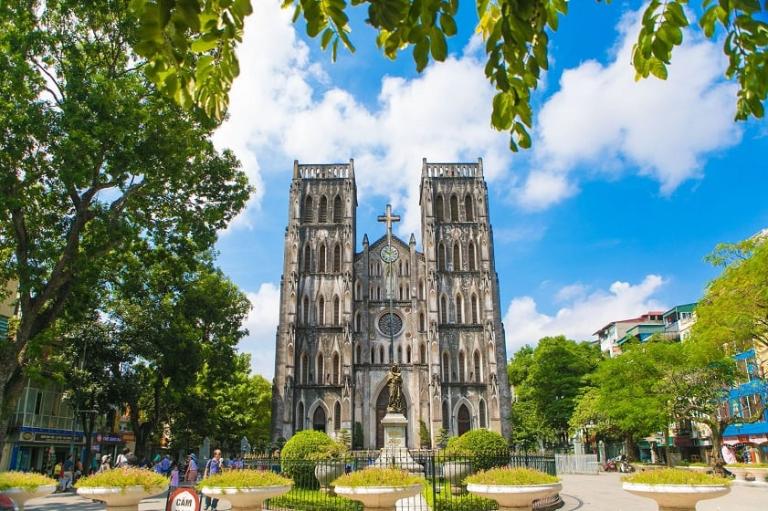
History of St. Joseph’s Cathedral
Not only a major religious structure, St. Joseph’s Cathedral in Hanoi is also a monument reflecting the historical development of Vietnam, especially in the years of French colonialism. The history of the cathedral is intricately entwined with the political and cultural developments that molded late 19th-century Vietnam.
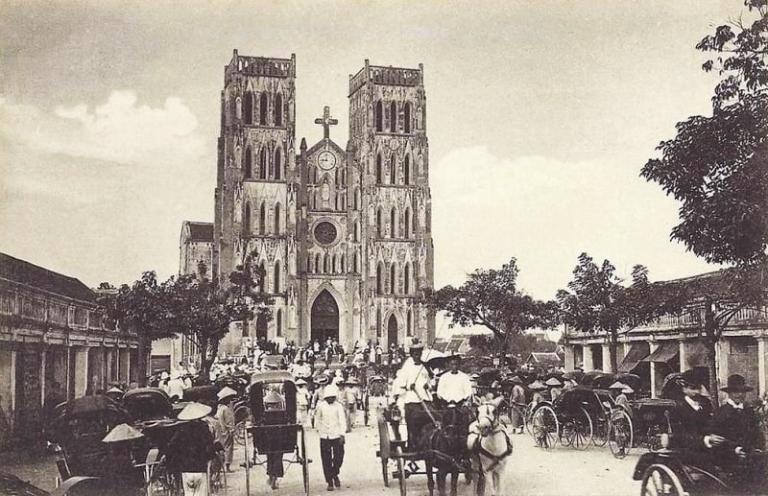
Initiated by the French colonial authority in line with their larger attempts to establish their presence in Vietnam, the building of St. Joseph’s Cathedral started in 1882. Under French control, Hanoi was undergoing fast change at this period, and many of the newly constructed structures mirrored European architectural forms.
Designed by a French architect influenced by French Gothic design, the church Inspired by the Notre-Dame Cathedral in Paris, the design emphasizes the French aim to copy their religious and cultural legacy in their colonies. The building took four years, and the cathedral was formally finished and opened on December 24, 1886, following a somber Christmas mass.
Completing the cathedral also signaled the founding of the Roman Catholic Archdiocese of Hanoi, with St. Joseph’s principal church. This was a major turning point in the evolution of Catholicism in Vietnam since the cathedral developed as the main gathering place for the expanding Catholic population in the northern nation.
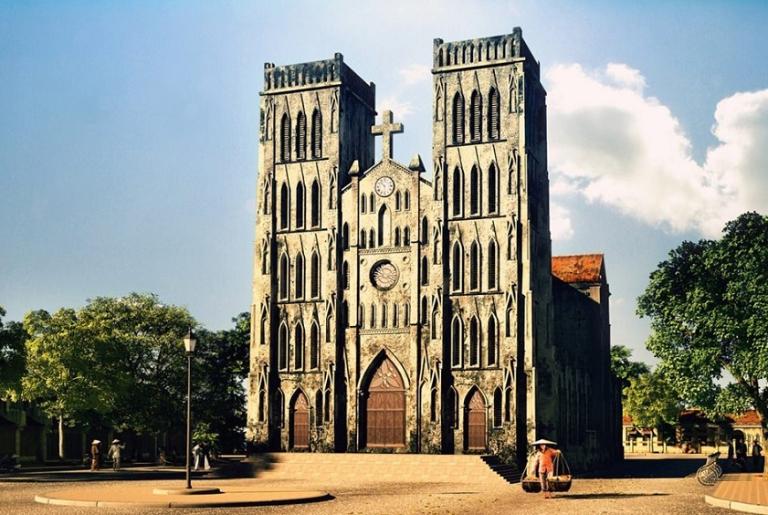
St. Joseph’s Cathedral saw several significant historical events over the years. For the Catholic community, the cathedral represented resilience during the stormy years of the 20th century, especially during the wars of freedom against the French and subsequently the Americans. Notwithstanding the political and social changes, the cathedral kept running as a place of worship, giving many people hope and comfort.
St. Joseph’s Cathedral now is a proud reminder of Hanoi’s colonial heritage, its architectural grace echoing the French impact on the city. This is a location where history, religion, and culture come together to provide both residents and guests a strong link to the past while still being essential component of the spiritual life of the society.
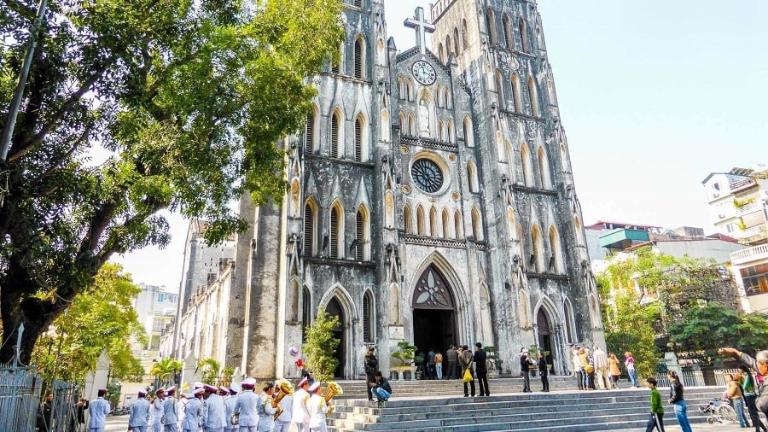
>>> Let’s see more: Thang Long Imperial Citadel: Explore Vietnam’s Timeless Heritage
Architectural Style of St. Joseph’s Cathedral
Emerging in Europe during the late medieval period and seeing a rebirth in popularity throughout the 19th century, Gothic Revival architecture is strikingly displayed at St. Joseph’s Cathedral in Hanoi. Drawing mostly on this architectural legacy, the architecture of the cathedral reflects the grandeur and seriousness of European cathedrals, especially the well-known Notre-Dame Cathedral in Paris.
Exterior Design
St. Joseph’s Cathedral is most notable for its twin bell towers, which dominate the surrounding skyline and rise 31.5 meters tall. A feature of Gothic design, pointed spires cap these towers to represent the link between heaven and earth.
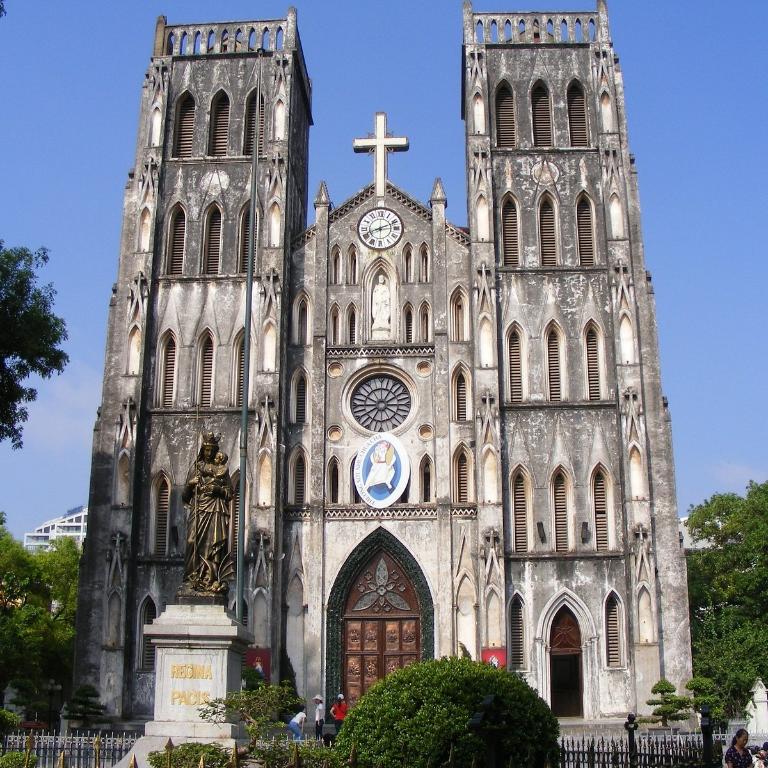
With its huge central rose window and pointed arches framing the main entrance, the somewhat plain yet striking front is built from granite stone. Emphasized by the tall spires and small windows, the verticality of the design is meant to pull the eye upward and inspire awe and respect.
Gothic Revival Elements
St. Joseph’s Cathedral falls under the Gothic Revival style, which is well-known for stressing verticality, elaborate decoration, and the use of light to provide a spiritual environment. The pointed arches, ribbed vaults, and flying buttresses of the cathedral clearly show this approach.
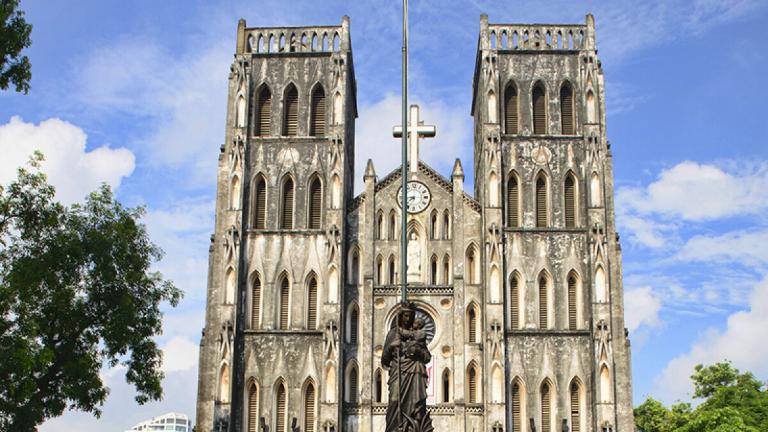
From the doors to the windows, the pointed arches—both structural and ornamental—are a mainstay of Gothic architecture and find great use across the cathedral. These arches enable the huge windows typical of Gothic churches by helping to distribute the weight of the walls and roof.
>>> Let’s explore: Hanoi Opera House: A Cultural Gem in Vietnam
Interior Design
Visitors entering St. Joseph’s Cathedral are met with a high vaulted ceiling reminiscent of another feature of Gothic architecture—supported by a sequence of ribbed vaults. The ribbed vaults create a skeletal framework that both supports the structure and accentuates the height of the cathedral, therefore allowing the spacious and airy interior. Two aisles separating rows of tall, thin columns accentuate the vertical focus of the space from the nave.
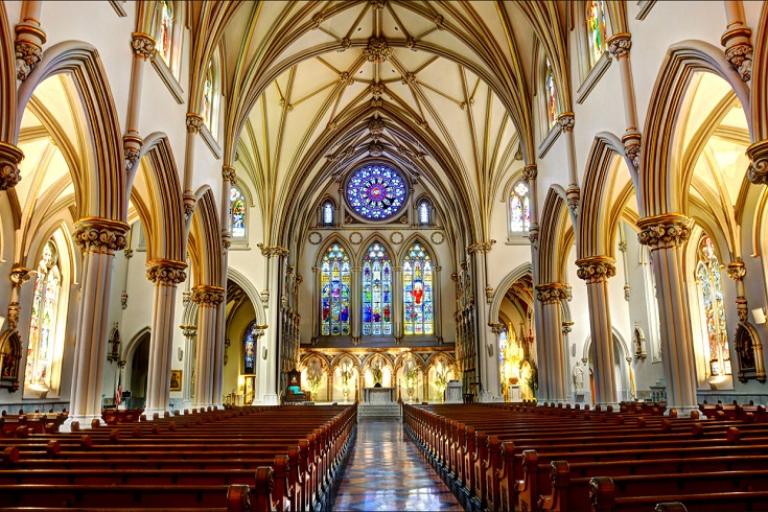
Another center of attention in the interior design of the church is its altar. Beautifully ornamented, the wooden altar shows religious themes and episodes from Christ’s life by means of complex carvings. Similar intricacy in the hardwood pews, pulpit, and other furniture reflects the fusion of European and Vietnamese artistry that defines the cathedral.
Stained Glass Windows
St. Joseph’s Cathedral’s stained glass windows are among its most striking elements. Brought from France, these windows show different biblical events and saints, so giving narrative and color to the inside space. Apart from design, the stained glass windows help the congregation to communicate religious tales and meaning. Sunlight streaming through these windows paints the inside in a rainbow of hues, therefore enhancing the calm and almost magical environment that accentuates the guests’ spiritual experience.
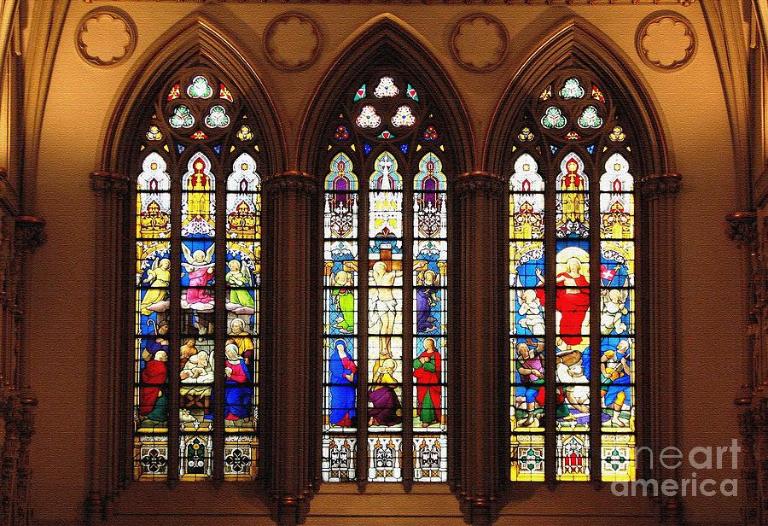
Influence of Notre-Dame Cathedral
Many facets of the design of St. Joseph’s Cathedral clearly reflect Notre-Dame Cathedral’s impact in Paris. Inspired by the Parisian cathedral are the general plan, the usage of Gothic features, and the stress on height and light. St. Joseph’s Cathedral does, however, also use local materials and workmanship, therefore producing a distinctive fusion of French Gothic design with Vietnamese cultural aspects.
>>> Let’s discover: Ho Chi Minh Mausoleum: A Comprehensive Guide to Vietnam’s Iconic Landmark
Cultural Significance of St. Joseph’s Cathedral
Apart from a remarkable architectural monument, St. Joseph’s Cathedral is a deeply ingrained emblem of cultural and religious value in Hanoi. Its significance goes beyond mere house of worship; it is evidence of the resiliency and faith of the Vietnamese Catholic community as well as a result of the mixing of local and international influences.
A Beacon of Faith for the Catholic Community
For more than a century, the Catholic community of Hanoi has its spiritual center in St. Joseph’s Cathedral. The Roman Catholic Archdiocese of Hanoi’s cathedral, which organizes daily mass, baptisms, weddings, and funerals among other religious events, is a hive for religious gatherings and social devotion as the seat of the archdiocese.
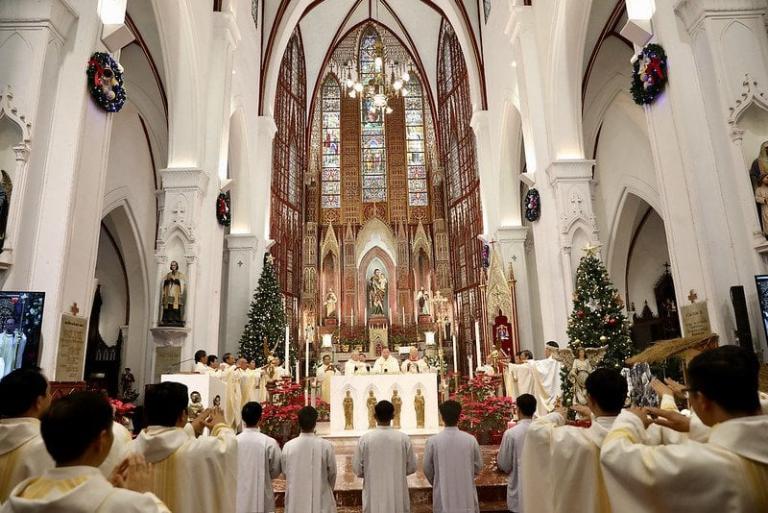
Particularly important in big Christian celebrations like Easter and Christmas is the cathedral. The cathedral turns into a hive of activity during these times, attracting not only the devout but also persons from many religious backgrounds. Among the most looked forward events of the year in Hanoi is the Christmas Eve Mass at St. Joseph’s Cathedral.
A Symbol of Resilience and Cultural Fusion
Particularly in relation to Vietnam’s contacts with Western countries, St. Joseph’s Cathedral reflects the convoluted history of that nation. Constructed in the 19th century by the French colonial authority, the cathedral represents the ongoing impact of European civilization on Vietnam. Still, it also shows how flexible the indigenous population is in incorporating these alien components into their own cultural identity.

The cathedral has evolved over time from a mere emblem of colonial past to a component of the local people’s cultural landscape accepted. From the busy street markets around the cathedral to the little stores selling holy relics nearby, this is clear in the way the building fits the daily lives of Hanoi’s people. The cathedral is a live tribute to the cultural blending that defines most of Vietnamese history.
Community Involvement and Social Significance
St. Joseph’s Cathedral is important not only for religious but also for social and cultural events, thereby acting as a venue for gatherings of people. The cathedral often conducts educational programs, cultural events, and charitable initiatives as well as These events create a feeling of community and give those from diverse backgrounds a forum to gather.
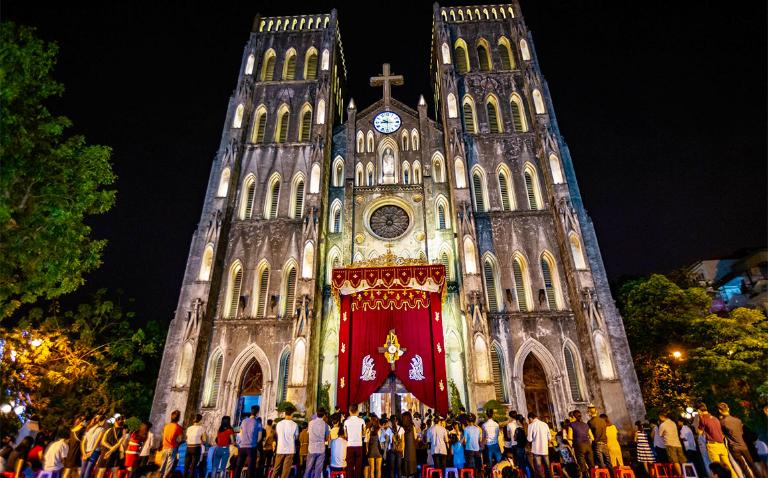
Furthermore, the cathedral has participated in interfaith conversations and projects meant to foster harmony between other religious groups living in Hanoi. In a nation with great religious and cultural variety, the cathedral is rather important in helping to close gaps and promote mutual respect among many communities.
>>> Article for you: Phung Hung Mural Street: A Vibrant Tapestry of Art and Culture in Hanoi
Visiting St. Joseph’s Cathedral
St. Joseph’s Cathedral is a must-see landmark for anyone traveling to Hanoi, providing a combination of architectural beauty, historical relevance, and spiritual depth. Here is what you need know to maximize your trip:
Location and How to Get There
Located in the Hoan Kiem area of Hanoi, at 40 Nha Chung Street, St. Joseph’s Cathedral is Particularly if you are staying in the Old Quarter, which is just a short walk away, this great position makes it readily accessible from many areas of the city. Nestled among busy streets dotted with cafes, stores, and colonial-era buildings, the cathedral is a major highlight of this ancient area.
To reach the cathedral, you can opt for several transportation options:
- Walking: Walking is the most handy approach to go to the cathedral if you live close by. This lets you explore the little Old Quarter streets and really absorb the local vibe.
- Taxi: Taxis are easily found all throughout Hanoi; from most central areas, a ride to the cathedral should take no more than 10 to 15 minutes.
- Motorbike: Renting a motorbike is a common approach for people seeking a more daring experience to go about Hanoi. Be careful, though, given the city’s busy traffic—especially at peak hours.
In addition, to enhance your experience, you can choose guided tours like Hanoi Motorbike Tours. They will provide a comprehensive overview of St. Joseph’s Cathedral’s history and significance

Best Time to Visit
Visiting St. Joseph’s Cathedral is best done early in the morning or late in the day. The gentle light during these times creates a lovely atmosphere for photography, and the less packed cathedral lets one have a more serene and reflective experience.
- Morning Visits: Arriving early in the morning not only helps you escape the crowds but also allows you to see the daily lives of Hanoi’s citizens as they go about their morning activities. Usually opening about 5:30 AM, the cathedral lets early risers savor the calm environment and the morning light softly lighting the facade.
- Afternoon Visits: If you prefer visiting in the afternoon, try to arrive around 3:00 to 4:00 PM. The lighting is still perfect for photos; you can tour the cathedral at your own speed before it shuts for the day.
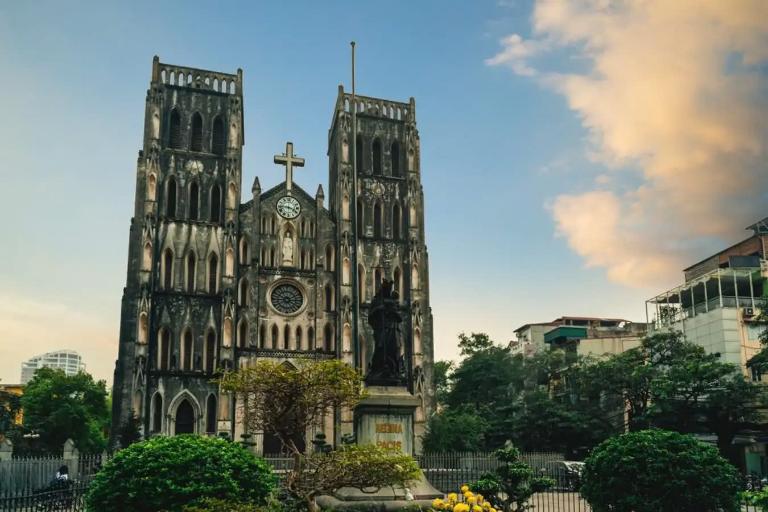
Entry Requirements
Although St. Joseph’s Cathedral is available to visitors, there are several rules to follow even though it is an active house of worship:
- Admission: Admission to the cathedral is free; nonetheless, gifts are valued particularly during events or services.
- Dress Code: Everyone should wear modest attire. Common expectation of religious sites in Vietnam is that visitors cover their knees and shoulders. This respects the hallowed character of the cathedral.
- Behavior: Being a religious site means that one should keep a calm and polite manner. Visitors should not use flash photography within the cathedral, refrain from loud talks, and be careful not to disturb continuous prayers or events.
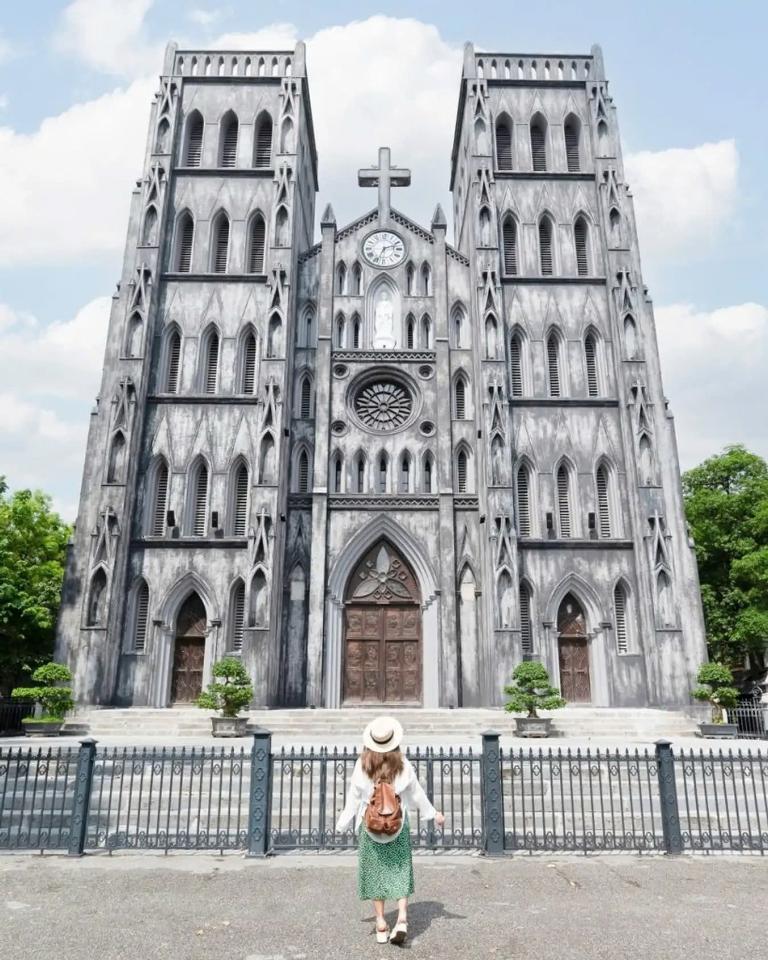
Nearby St. Joseph’s Cathedral Attractions
Following a visit to St. Joseph’s Cathedral, there are many more nearby sites deserving of exploration:
- Hoan Kiem Lake: Just a short walk away, Hoan Kiem Lake is a quiet haven in the middle of the city ideal for a leisurely stroll or a break from sight-seeing.
- Ngoc Son Temple: One of the most visited places in Hanoi, Ngoc Son Temple provides insight into the spiritual and cultural legacy of the city from an island in Hoan Kiem Lake.
- Hanoi Old Quarter: Wander around the little lanes of Hanoi’s Old Quarter, where you will discover a vivid mix of local markets, stores, and ancient buildings.

St. Joseph’s Cathedral is a timeless treasure that has stood the test of time. It is a symbol of faith, culture, and history and a must-see destination for anyone visiting Hanoi. The beauty, background, and importance of the church provide a very remarkable experience.
Related Posts:
- Tay Ho Palace: A Famous Spiritual Destination in Hanoi
- Discover Hang Gai Street: A refuge for excellent silk goods
- Explore the Rich History and Culture of Hang Bac Street in Hanoi
- Thang Long Water Puppet Theatre: Hanoi’s Cultural Masterpiece
- Old City Gate Hanoi: A Historical Landmark in the Heart of the Old Quarter












Be the first to comment!